广州版小学一年级英语口语Unit 5 Here is my scooter play
- 格式:ppt
- 大小:5.63 MB
- 文档页数:13
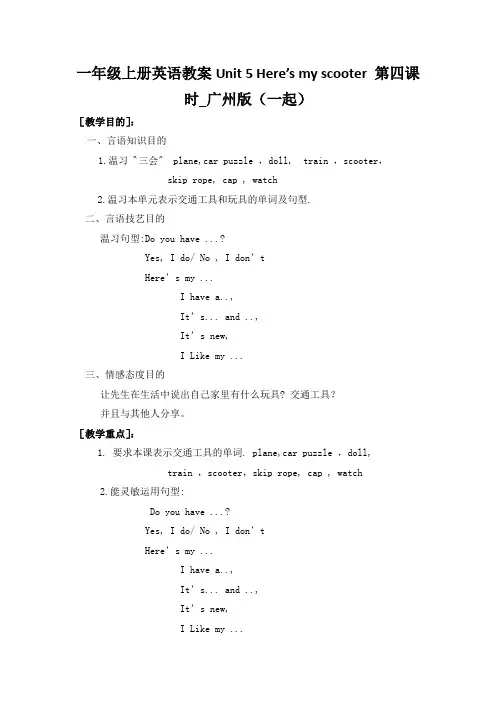
一年级上册英语教案Unit 5 Here’s my scooter 第四课时_广州版(一起)[教学目的]:一、言语知识目的1.温习〝三会〞 plane,car puzzle ,doll, train ,scooter,skip rope, cap , watch2.温习本单元表示交通工具和玩具的单词及句型.二、言语技艺目的温习句型:Do you have ...?Yes, I do/ No , I don’tHere’s my ...I have a..,It’s... and ..,It’s new,I Like my ...三、情感态度目的让先生在生活中说出自己家里有什么玩具? 交通工具?并且与其他人分享。
[教学重点]:1.要求本课表示交通工具的单词. plane,car puzzle ,doll,train ,scooter,skip rope, cap , watch2.能灵敏运用句型:Do you have ...?Yes, I do/ No , I don’tHere’s my ...I have a..,It’s... and ..,It’s new,I Like my ...[教学难点]:能灵敏运用句型: It’s... and .., It’s new, [教学进程]:一、.Leading-in:温习歌曲Do you have a plane/a car?〔吸引先生的留意力和调动其学习积极性。
〕二、Presentation:1. 温习歌谣Here’s my puzzle,Here’s my plane,Here’s my doll.Here’s my trainHere’s my scooterIn the rain2. 温习show and tellI have a..,It’s... and ..,It’s new,I Like my ..3.I have a train ,It’s red and green .It’s new,I like my train4.I have a skip rope.It’s red. It’s newI like my skip rope.5.Stroy time作业布置给家长唱英文歌«Merry Christmas»板书设计:Do you have ...?Yes, I do/ No , I don’t 教学反思:。
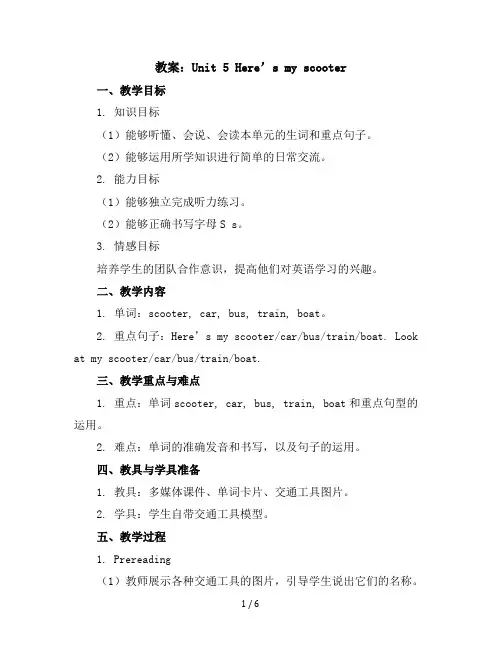
教案:Unit 5 Here’s my scooter一、教学目标1. 知识目标(1)能够听懂、会说、会读本单元的生词和重点句子。
(2)能够运用所学知识进行简单的日常交流。
2. 能力目标(1)能够独立完成听力练习。
(2)能够正确书写字母S s。
3. 情感目标培养学生的团队合作意识,提高他们对英语学习的兴趣。
二、教学内容1. 单词:scooter, car, bus, train, boat。
2. 重点句子:Here’s my scooter/car/bus/train/boat. Look at my scooter/car/bus/train/boat.三、教学重点与难点1. 重点:单词scooter, car, bus, train, boat和重点句型的运用。
2. 难点:单词的准确发音和书写,以及句子的运用。
四、教具与学具准备1. 教具:多媒体课件、单词卡片、交通工具图片。
2. 学具:学生自带交通工具模型。
五、教学过程1. Prereading(1)教师展示各种交通工具的图片,引导学生说出它们的名称。
(2)引导学生预测故事内容。
2. Whilereading(1)学生听录音,跟读课文。
(2)教师提问,检查学生对课文内容的理解。
(3)学生分组讨论,用所学单词和句子进行交流。
3. Postreading(1)学生表演课文故事。
(2)学生展示自带的交通工具模型,并用所学句子进行介绍。
六、板书设计1. Unit 5 Here’s my scooter2. Words: scooter, car, bus, train, boat3. Sentences: Here’s my scooter/car/bus/train/boat. Look at my scooter/car/bus/train/boat.七、作业设计1. 抄写单词scooter, car, bus, train, boat各5次。
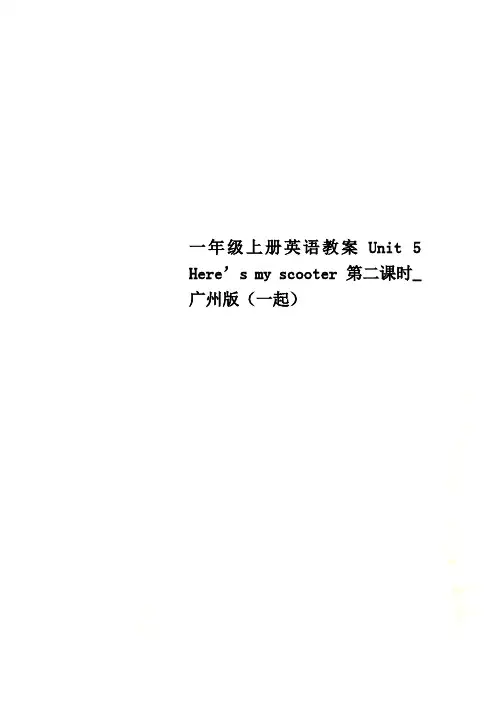
一年级上册英语教案Unit 5 Here’s my scooter 第二课时_广州版(一起)randomly. The children raise and show their toys.The teacher shows the children a toy car and says “Here’s my car.” The children follow the example and show their toys to each other by saying “Here’s my…”Activity 3: let’s chantThe children listen to the chant and raise the corresponding toys or pictures at the same timeListen to the tape againChant after the recorderChant the rhyme together, then group by group, finally one by one. Activity 4: Recognize the new wordsThe teacher puts the chant and some pictures of the new words on the blackboard.Ask the children to read the chant then find out and point at the words: puzzle, plane, doll, train, and scooter one by one.Stick the proper pictures besides the wordsActivity 5: End the classGive a comment on how the children have done in this lessonRemind the children to chant the rhyme to their parents and friends Encourage the children to create a new chant by using the words about stationery.作业布置给家长说英文歌谣《 here is …》板书设计:单词:plane , car ,scooter句型: here is ...教学反思:。
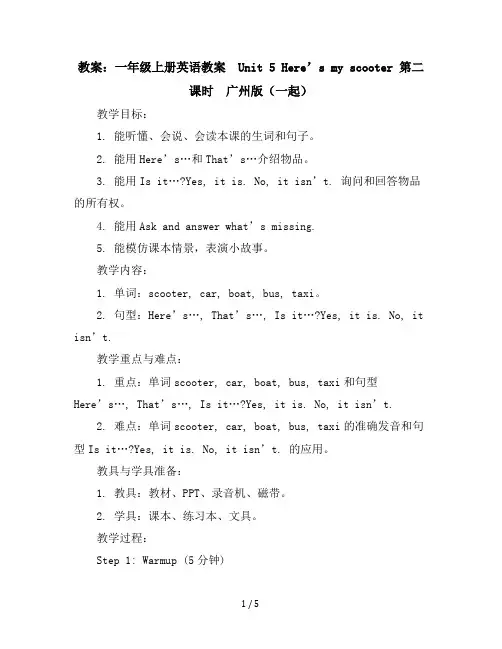
教案:一年级上册英语教案Unit 5 Here’s my scooter 第二课时广州版(一起)教学目标:1. 能听懂、会说、会读本课的生词和句子。
2. 能用Here’s…和That’s…介绍物品。
3. 能用Is it…?Yes, it is. No, it isn’t. 询问和回答物品的所有权。
4. 能用Ask and answer what’s missing.5. 能模仿课本情景,表演小故事。
教学内容:1. 单词:scooter, car, boat, bus, taxi。
2. 句型:Here’s…, That’s…, Is it…?Yes, it is. No, it isn’t.教学重点与难点:1. 重点:单词scooter, car, boat, bus, taxi和句型Here’s…, That’s…, Is it…?Yes, it is. No, it isn’t.2. 难点:单词scooter, car, boat, bus, taxi的准确发音和句型Is it…?Yes, it is. No, it isn’t. 的应用。
教具与学具准备:1. 教具:教材、PPT、录音机、磁带。
2. 学具:课本、练习本、文具。
教学过程:Step 1: Warmup (5分钟)1. 教师与学生用Hello, good morning/afternoon/evening等问候语打招呼。
2. 学生表演唱歌或跳舞,活跃课堂气氛。
Step 2: Presentation (10分钟)1. 教师出示单词卡片,引导学生说出单词。
2. 教师用Here’s my scooter, is it yours?引导学生用Yes, it is. No, it isn’t.回答。
3. 学生两人一组,模仿课本情景,用Here’s…和Is it…?Yes, it is. No, it isn’t.进行练习。
Step 3: Practice (10分钟)1. 学生听录音,跟读单词和句子。
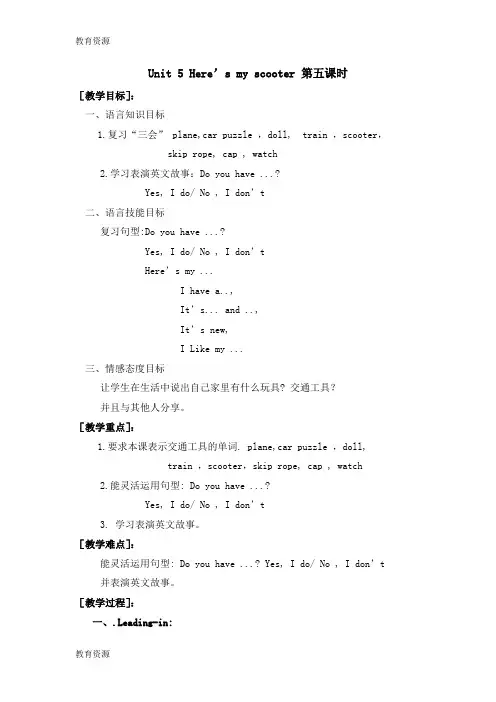
Unit 5 Here’s my scooter 第五课时[教学目标]:一、语言知识目标1.复习“三会” plane,car puzzle ,doll, train ,scooter,skip rope, cap , watch2.学习表演英文故事:Do you have ...?Yes, I do/ No , I don’t二、语言技能目标复习句型:Do you have ...?Yes, I do/ No , I don’tHere’s my ...I have a..,It’s... and ..,It’s new,I Like my ...三、情感态度目标让学生在生活中说出自己家里有什么玩具? 交通工具?并且与其他人分享。
[教学重点]:1.要求本课表示交通工具的单词. plane,car puzzle ,doll,train ,scooter,skip rope, cap , watch2.能灵活运用句型: Do you have ...?Yes, I do/ No , I don’t3. 学习表演英文故事。
[教学难点]:能灵活运用句型: Do you have ...? Yes, I do/ No , I don’t 并表演英文故事。
[教学过程]:一、.Leading-in:复习歌曲Do you have a plane/a car?(吸引学生的注意力和调动其学习积极性。
)二、Presentation:1. 复习歌谣Here’s my puzzle,Here’s my plane,Here’s my doll.Here’s my trainHere’s my scooterIn the rain2.学习表演故事 Stroy timeI have a bag,Do you have a bag?Yes , I do.I Have a cap,Do you have a cap?Yes , I do.I Have a watch,Do you have a watch?Yes , I do.I Have a scooter,Do you have a scooter?Yes , I do.I Have a tail,Do you have a tail?No, I don,t作业布置给家长表演故事I Have a..板书设计:I Have aDo you have ...?Yes, I do/ No , I don’t 教学反思:。
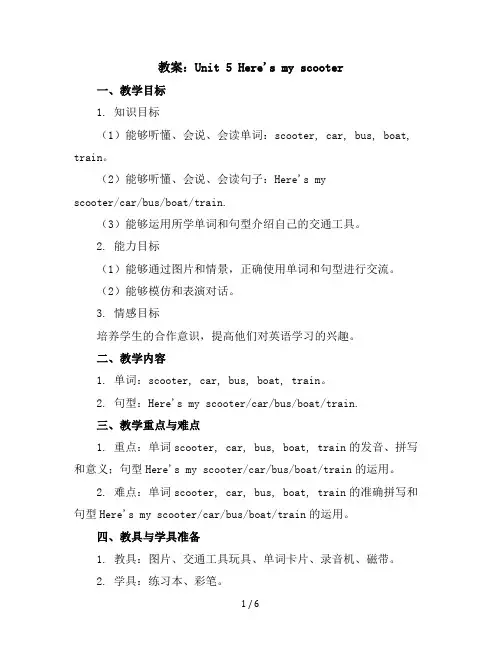
教案:Unit 5 Here's my scooter一、教学目标1. 知识目标(1)能够听懂、会说、会读单词:scooter, car, bus, boat, train。
(2)能够听懂、会说、会读句子:Here's myscooter/car/bus/boat/train.(3)能够运用所学单词和句型介绍自己的交通工具。
2. 能力目标(1)能够通过图片和情景,正确使用单词和句型进行交流。
(2)能够模仿和表演对话。
3. 情感目标培养学生的合作意识,提高他们对英语学习的兴趣。
二、教学内容1. 单词:scooter, car, bus, boat, train。
2. 句型:Here's my scooter/car/bus/boat/train.三、教学重点与难点1. 重点:单词scooter, car, bus, boat, train的发音、拼写和意义;句型Here's my scooter/car/bus/boat/train的运用。
2. 难点:单词scooter, car, bus, boat, train的准确拼写和句型Here's my scooter/car/bus/boat/train的运用。
四、教具与学具准备1. 教具:图片、交通工具玩具、单词卡片、录音机、磁带。
2. 学具:练习本、彩笔。
五、教学过程1. 热身(5分钟)(1)教师与学生用Hello, good morning/afternoon/evening! How are you?等问候语互相问候。
(2)教师引导学生唱英文歌曲《Here we go》。
2. 引入(10分钟)(1)教师出示交通工具图片,引导学生说出单词:scooter, car, bus, boat, train。
(2)教师出示句子Here's my scooter/car/bus/boat/train,引导学生跟读。

一年级上册英语教案Unit 5 Here’s my scooter 第二课时_广州版(一起)[教学目的]:一、言语知识目的1.能懂〝三会〞 puzzle ,doll, train ,scooter。
2.要求掌握本课表示交通工具的单词.二、言语技艺目的能灵敏运用句型: Here is my ...三、情感态度目的让先生在生活中说出自己家里有什么玩具? 交通工具?并且与其他人分享。
[教学重点]:1.要求本课表示交通工具的单词. puzzle ,doll, train ,scooter2.能灵敏运用句型: Here is my ...[教学难点]:能灵敏运用句型: Here is my ...[教学进程]:一、.Leading-in:温习歌曲Do you have a little plane/car? 〔吸引先生的留意力和调动其学习积极性。
〕二、Presentation:Activity 1: song 〝 I have a new pencil〞The teacher shows the children a bag and asks them to guess what’s in it?The teacher takes out a pencil when the children guess pencilThe children show their pencils and sing the song 〝 I have a new pencil〞Activity 2:The children take out all the toys they brought from home and put them on the desk.The teacher says the words 〝puzzle, plane, doll, train, scooter〞randomly. The children raise and show their toys.The teacher shows the children a toy car and says 〝Here’s my car.〞 The children follow the example and show their toys to each other by saying 〝Here’s my…〞Activity 3:let’s chantThe children listen to the chant and raise the corresponding toys or pictures at the same timeListen to the tape againChant after the recorderChant the rhyme together, then group by group, finally one by one. Activity 4: Recognize the new wordsThe teacher puts the chant and some pictures of the new words on the blackboard.Ask the children to read the chant then find out and point at the words: puzzle, plane, doll, train, and scooter one by one.Stick the proper pictures besides the wordsActivity 5: End the classGive a comment on how the children have done in this lessonRemind the children to chant the rhyme to their parents and friends Encourage the children to create a new chant by using the words about stationery.作业布置给家长说英文歌谣« here is …»板书设计:单词:plane , car ,scooter句型: here is ...教学反思:。

Unit 5 Here’s my scooter 第二课时其实,任何一门学科都离不开死记硬背,关键是记忆有技巧,“死记”之后会“活用”。
不记住那些基础知识,怎么会向高层次进军?尤其是语文学科涉猎的范围很广,要真正提高学生的写作水平,单靠分析文章的写作技巧是远远不够的,必须从基础知识抓起,每天挤一点时间让学生“死记”名篇佳句、名言警句,以及丰富的词语、新颖的材料等。
这样,就会在有限的时间、空间里给学生的脑海里注入无限的内容。
日积月累,积少成多,从而收到水滴石穿,绳锯木断的功效。
[教学目标]:死记硬背是一种传统的教学方式,在我国有悠久的历史。
但随着素质教育的开展,死记硬背被作为一种僵化的、阻碍学生能力发展的教学方式,渐渐为人们所摒弃;而另一方面,老师们又为提高学生的语文素养煞费苦心。
其实,只要应用得当,“死记硬背”与提高学生素质并不矛盾。
相反,它恰是提高学生语文水平的重要前提和基础。
一、语言知识目标“师”之概念,大体是从先秦时期的“师长、师傅、先生”而来。
其中“师傅”更早则意指春秋时国君的老师。
《说文解字》中有注曰:“师教人以道者之称也”。
“师”之含义,现在泛指从事教育工作或是传授知识技术也或是某方面有特长值得学习者。
“老师”的原意并非由“老”而形容“师”。
“老”在旧语义中也是一种尊称,隐喻年长且学识渊博者。
“老”“师”连用最初见于《史记》,有“荀卿最为老师”之说法。
慢慢“老师”之说也不再有年龄的限制,老少皆可适用。
只是司马迁笔下的“老师”当然不是今日意义上的“教师”,其只是“老”和“师”的复合构词,所表达的含义多指对知识渊博者的一种尊称,虽能从其身上学以“道”,但其不一定是知识的传播者。
今天看来,“教师”的必要条件不光是拥有知识,更重于传播知识。
1.能懂“三会”puzzle ,doll, train ,scooter。
2.要求掌握本课表示交通工具的单词.二、语言技能目标能灵活运用句型: Here is my ...三、情感态度目标让学生在生活中说出自己家里有什么玩具? 交通工具?并且与其他人分享。
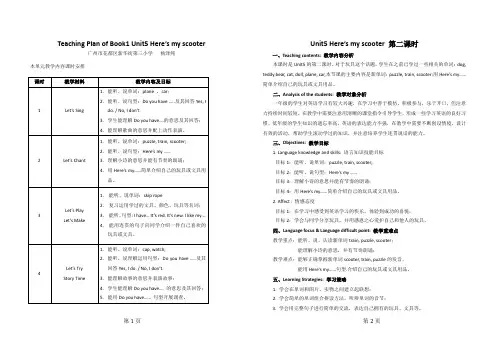
Teaching Plan of Book1 Unit5 Here’s my scooter广州市花都区新华街第三小学杨泽纯本单元教学内容课时安排Unit5 Here’s my scooter 第二课时一、Teaching contents: 教学内容分析本课时是Unit5的第二课时。
对于玩具这个话题,学生在之前已学过一些相关的单词:dog, teddy bear, cat, doll, plane, car,本节课的主要内容是新单词:puzzle, train, scooter;用Here’s my……简单介绍自己的玩具或文具用品。
二、Analysis of the students: 教学对象分析一年级的学生对英语学习有较大兴趣,在学习中善于模仿,积极参与,乐于开口,但注意力持续时间较短,在教学中需要注意用清晰的课堂指令引导学生,形成一些学习英语的良好习惯。
低年级的学生知识的遗忘率高,英语的表达能力不强,在教学中需要不断创设情境,设计有效的活动,帮助学生滚动学过的知识,并注意培养学生连贯说话的能力。
三、Objectives: 教学目标1. Language knowledge and skills: 语言知识技能目标目标1:能听、说单词:puzzle, train, scooter;目标2:能听、说句型:Here’s my ……目标3:理解小诗的意思并能有节奏的朗诵;目标4:用Here’s my……简单介绍自己的玩具或文具用品。
2. Affect : 情感态度目标1:在学习中感受到英语学习的快乐,体验到成功的喜悦;目标2:学会与同学分享玩具,并用感恩之心爱护自己和他人的玩具。
四、Language focus & Language difficult point: 教学重难点教学重点:能听、说、认读新单词train, puzzle, scooter;能理解小诗的意思,并有节奏朗诵;教学难点:能够正确掌握新单词scooter, train, puzzle的发音。
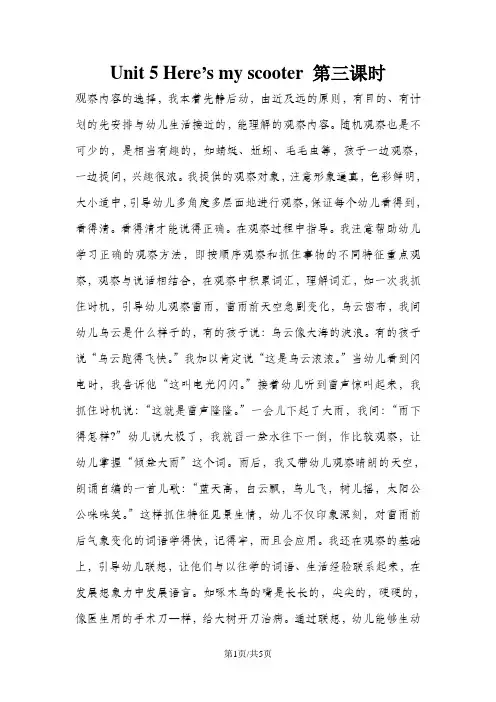
Unit 5 Here’s my scooter 第三课时观察内容的选择,我本着先静后动,由近及远的原则,有目的、有计划的先安排与幼儿生活接近的,能理解的观察内容。
随机观察也是不可少的,是相当有趣的,如蜻蜓、蚯蚓、毛毛虫等,孩子一边观察,一边提问,兴趣很浓。
我提供的观察对象,注意形象逼真,色彩鲜明,大小适中,引导幼儿多角度多层面地进行观察,保证每个幼儿看得到,看得清。
看得清才能说得正确。
在观察过程中指导。
我注意帮助幼儿学习正确的观察方法,即按顺序观察和抓住事物的不同特征重点观察,观察与说话相结合,在观察中积累词汇,理解词汇,如一次我抓住时机,引导幼儿观察雷雨,雷雨前天空急剧变化,乌云密布,我问幼儿乌云是什么样子的,有的孩子说:乌云像大海的波浪。
有的孩子说“乌云跑得飞快。
”我加以肯定说“这是乌云滚滚。
”当幼儿看到闪电时,我告诉他“这叫电光闪闪。
”接着幼儿听到雷声惊叫起来,我抓住时机说:“这就是雷声隆隆。
”一会儿下起了大雨,我问:“雨下得怎样?”幼儿说大极了,我就舀一盆水往下一倒,作比较观察,让幼儿掌握“倾盆大雨”这个词。
雨后,我又带幼儿观察晴朗的天空,朗诵自编的一首儿歌:“蓝天高,白云飘,鸟儿飞,树儿摇,太阳公公咪咪笑。
”这样抓住特征见景生情,幼儿不仅印象深刻,对雷雨前后气象变化的词语学得快,记得牢,而且会应用。
我还在观察的基础上,引导幼儿联想,让他们与以往学的词语、生活经验联系起来,在发展想象力中发展语言。
如啄木鸟的嘴是长长的,尖尖的,硬硬的,像医生用的手术刀―样,给大树开刀治病。
通过联想,幼儿能够生动形象地描述观察对象。
[教学目标]:要练说,先练胆。
说话胆小是幼儿语言发展的障碍。
不少幼儿当众说话时显得胆怯:有的结巴重复,面红耳赤;有的声音极低,自讲自听;有的低头不语,扯衣服,扭身子。
总之,说话时外部表现不自然。
我抓住练胆这个关键,面向全体,偏向差生。
一是和幼儿建立和谐的语言交流关系。
每当和幼儿讲话时,我总是笑脸相迎,声音亲切,动作亲昵,消除幼儿畏惧心理,让他能主动的、无拘无束地和我交谈。
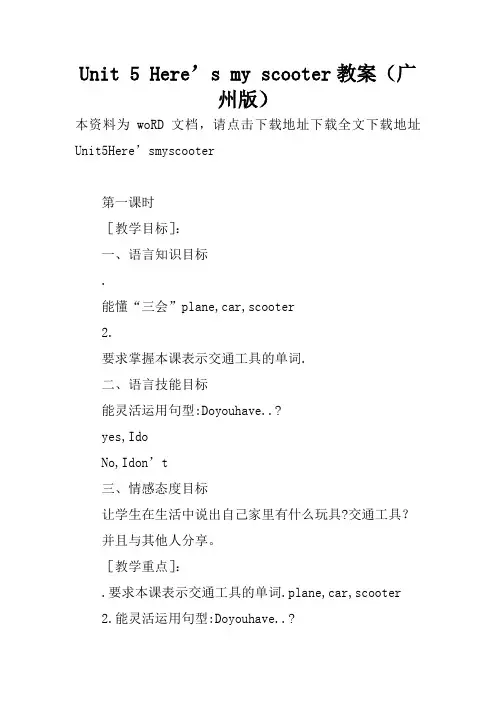
Unit 5 Here’s my scooter教案(广州版)本资料为woRD文档,请点击下载地址下载全文下载地址Unit5Here’smyscooter第一课时[教学目标]:一、语言知识目标.能懂“三会”plane,car,scooter2.要求掌握本课表示交通工具的单词.二、语言技能目标能灵活运用句型:Doyouhave..?yes,IdoNo,Idon’t三、情感态度目标让学生在生活中说出自己家里有什么玩具?交通工具?并且与其他人分享。
[教学重点]:.要求本课表示交通工具的单词.plane,car,scooter2.能灵活运用句型:Doyouhave..?yes,IdoNo,Idon’t[教学难点]:能灵活运用句型:Doyouhave..?[教学过程]:一、.Leading-in:学习歌曲Doyouhavealittleplane/car?(吸引学生的注意力和调动其学习积极性。
)二、Presentation:.Presentthenewwords:承接以上歌曲,问学生是否有littleplaneorlittlecar.。
然后出示书包,并告诉学生老师的书包里有很多小玩具,那是老师为Ben的生日准备的,请同学们猜猜老师为Ben准备了什么礼物。
最后把小玩具一件一件从书包里拿出,看看是否有学生猜对,并把有关的图片贴在黑板上。
carbusplanespaceshipbikeship老师带读单词,然后全班齐读,再以接龙的形式做练习。
2.Presentthesentence:Doyouhave……?做完接龙的游戏后,让全班同学看黑板上的图。
老师指着其中一幅图问学生“Isitabus/car/plane/spaceship/bike/ship?”并让学生用yes,itis./No,itisn’t.回答(如果学生只回答yes或者No,老师再加以引导其用yes,itis./No,itisn’t.回答)。
问完后,老师板书“Isita……?”并让学生猜猜这个句子的中文意思。
一年级上册英语教案Unit 5 Here’s my scooter 第五课时广州版(一起)一、教学目标1. 知识目标:(1)能够听懂、会说、会读本课时出现的单词和句型。
(2)能够运用所学单词和句型进行简单的日常交流。
2. 能力目标:(1)能够通过图片、情境等方式正确感知、理解和运用单词和句型。
(2)能够与他人合作,完成小组活动。
3. 情感目标:二、教学内容1. 单词:scooter, boat, ball, flower, bird2. 句型:Here’s my scooter/boat/ball/flower/bird.三、教学重点与难点1. 重点:单词scooter, boat, ball, flower, bird的认读和运用。
2. 难点:单词bird的读音和书写,句型Here’s myscooter/boat/ball/flower/bird. 的运用。
四、教具与学具准备1. 教具:PPT、单词卡片、实物等。
2. 学具:学生书、练习册、文具等。
五、教学过程1. 热身(5分钟)(1)教师与学生互相问候,引导学生用英语问候。
(2)播放英语歌曲,让学生跟着音乐节奏进行律动。
2. 导入(10分钟)(1)教师出示单词卡片,引导学生认读单词scooter, boat, ball。
(2)教师通过情境展示,引导学生理解句型Here’s my scooter/boat/ball.3. 新课呈现(15分钟)(1)教师出示单词卡片,引导学生认读单词flower, bird。
(2)教师通过情境展示,引导学生理解句型Here’s my flower/bird.4. 课堂练习(10分钟)(1)学生书P37,完成第14题。
(2)学生书P38,完成第14题。
5. 小组活动(5分钟)学生分组,每组选择一个单词,用Here’s myscooter/boat/ball/flower/bird. 句型进行展示。
(1)教师带领学生复习本节课所学单词和句型。
Unit 5 Here’s my scooter 第二课时[教学目标]:一、语言知识目标1.能懂“三会” puzzle ,doll, train ,scooter。
2.要求掌握本课表示交通工具的单词.二、语言技能目标能灵活运用句型: Here is my ...三、情感态度目标让学生在生活中说出自己家里有什么玩具? 交通工具?并且与其他人分享。
[教学重点]:1.要求本课表示交通工具的单词. puzzle ,doll, train ,scooter2.能灵活运用句型: Here is my ...[教学难点]:能灵活运用句型: Here is my ...[教学过程]:一、.Leading-in:复习歌曲Do you have a little plane/car? (吸引学生的注意力和调动其学习积极性。
)二、Presentation:Activity 1: song “ I have a new pencil”The teacher shows the children a bag and asks them to guess what’s in it?The teacher takes out a pencil when the children guess pencilThe children show their pencils and sing the song “ I have a new pencil”Activity 2:The children take out all the toys they brought from home and put them on the desk.The teacher says the words “puzzle, plane, doll, train, scooter”randomly. The children raise and show their toys.The teacher shows the children a toy car and says “Here’s my car.” The children follow the example and show their toys to each other by saying “Here’s my…”Activity 3:let’s chantThe children listen to the chant and raise the corresponding toys or pictures at the same timeListen to the tape againChant after the recorderChant the rhyme together, then group by group, finally one by one. Activity 4: Recognize the new wordsThe teacher puts the chant and some pictures of the new words on the blackboard.Ask the children to read the chant then find out and point at the words: puzzle, plane, doll, train, and scooter one by one.Stick the proper pictures besides the wordsActivity 5: End the classGive a comment on how the children have done in this lessonRemind the children to chant the rhyme to their parents and friends Encourage the children to create a new chant by using the words about stationery.作业布置给家长说英文歌谣《 here is …》板书设计:单词:plane , car ,scooter句型: here is ...教学反思:。
Unit 5 Here’s my scooter 第五课时“教书先生”恐怕是市井百姓最为熟悉的一种称呼,从最初的门馆、私塾到晚清的学堂,“教书先生”那一行当怎么说也算是让国人景仰甚或敬畏的一种社会职业。
只是更早的“先生”概念并非源于教书,最初出现的“先生”一词也并非有传授知识那般的含义。
《孟子》中的“先生何为出此言也?”;《论语》中的“有酒食,先生馔”;《国策》中的“先生坐,何至于此?”等等,均指“先生”为父兄或有学问、有德行的长辈。
其实《国策》中本身就有“先生长者,有德之称”的说法。
可见“先生”之原意非真正的“教师”之意,倒是与当今“先生”的称呼更接近。
看来,“先生”之本源含义在于礼貌和尊称,并非具学问者的专称。
称“老师”为“先生”的记载,首见于《礼记?曲礼》,有“从于先生,不越礼而与人言”,其中之“先生”意为“年长、资深之传授知识者”,与教师、老师之意基本一致。
[教学目标]:课本、报刊杂志中的成语、名言警句等俯首皆是,但学生写作文运用到文章中的甚少,即使运用也很难做到恰如其分。
为什么?还是没有彻底“记死”的缘故。
要解决这个问题,方法很简单,每天花3-5分钟左右的时间记一条成语、一则名言警句即可。
可以写在后黑板的“积累专栏”上每日一换,可以在每天课前的3分钟让学生轮流讲解,也可让学生个人搜集,每天往笔记本上抄写,教师定期检查等等。
这样,一年就可记300多条成语、300多则名言警句,日积月累,终究会成为一笔不小的财富。
这些成语典故“贮藏”在学生脑中,自然会出口成章,写作时便会随心所欲地“提取”出来,使文章增色添辉。
一、语言知识目标与当今“教师”一称最接近的“老师”概念,最早也要追溯至宋元时期。
金代元好问《示侄孙伯安》诗云:“伯安入小学,颖悟非凡貌,属句有夙性,说字惊老师。
”于是看,宋元时期小学教师被称为“老师”有案可稽。
清代称主考官也为“老师”,而一般学堂里的先生则称为“教师”或“教习”。
可见,“教师”一说是比较晚的事了。
Unit 5 Here ’s my scooter 第五课时“教书先生”唯恐是街市百姓最为熟习的一种称号,从最先的门馆、私塾到晚清的学堂,“教书先生”那一行当怎么说也算是让国人仰慕甚或敬畏的一种社会职业。
不过更早的“先生”观点并不是源于教书,最先出现的“先生”一词也并不是有教授知识那般的含义。
《孟子》中的“先生何为出此言也?” ;《论语》中的“有酒食,先生馔”;《国策》中的“先生坐,何至于此?”等等,均指“先生”为父兄或有学问、有品德的尊长。
其实《国策》中自己就有“先生长辈,有德之称”的说法。
可见“先生”之原意非真实的“教师”之意,倒是与现在“先生”的称号更靠近。
看来,“先生”之根源含义在于礼貌和尊称,并非具学问者的专称。
称“老师”为“先生”的记录,首见于《礼记 ?曲礼》,有“从于先生,不越礼而与人言” ,此中之“先生”意为“年长、资深之教授知识者” ,与教师、老师之意基本一致。
[教课目的]:课本、报刊杂志中的成语、名言警语等俯首皆是,但学生写作文运用到文章中的甚少,即便运用也很难做到恰到好处。
为何?仍是没有完全“记死”的缘由。
要解决这个问题,方法很简单,每天花 3-5 分钟左右的时间记一条成语、一则名言警语即可。
能够写在后黑板的“累积专栏”上每天一换,能够在每天课前的 3 分钟让学生轮番解说,也可让学生个人收集,每天往笔录本上抄录,教师按期检查等等。
这样,一年便可记 300 多条成语、 300 多则名言警语,与日俱增,终归会成为一笔不小的财产。
这些成语典故“储藏”在学生脑中,自然会下笔成章,写作时便会为所欲为地“提取”出来,使文章添色添辉。
一、语言知识目标与现在“教师”一称最靠近的“老师”观点,最早也要追忆至宋元期间。
金代元好问《示侄孙伯安》诗云:“伯安入小学,颖悟非凡貌,属句有夙性,说字惊老师。
”于是看,宋元期间小学教师被称为“老师”有案可稽。
清朝称主考官也为“老师” ,而一般学堂里的先生则称为“教师”或“教习” 。